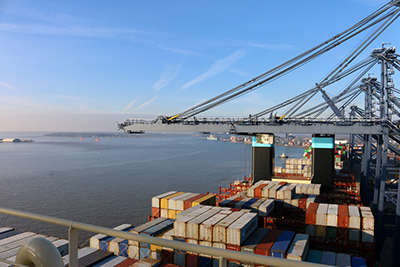Even before the recent cyber security attacks, ocean cargo analysts were urging ocean carriers to become more “connected.” Meanwhile, the industry continues to mired in overcapacity.
Owing to the structural overcapacity in the container industry, shippers have essentially had most of the pricing power since the financial crisis, says industry consultant Lars Jensen, CEO and partner of SeaIntelligence Consulting in Denmark. As a consequence, this has enabled shippers to benefit financially from the cost savings measures brought about by slow steaming, mega-vessels, vessel sharing and “skipped sailings.”
In his new book titled “Liner Shipping 2025,” Jensen observes that vessels ordered in 2014 and 2015 will continue to be delivered over the next two years, meaning high levels of scrapping are likely to continue. However, Jensen also notes that in 2019 and beyond, a disproportionate share of feeder-sized vessels will be reaching the end of their lifespan, and orders for their replacements are likely to surge.
“The good news is that their relatively small size means the impact on the overall global market will be limited,” adds Jensen.
In the meantime, carriers will still have to make some hard decisions for the remainder of 2017, says Esben Christensen, managing director of the international consultancy AlixPartners. “They've already taken steps to relieve their financial woes, including slashing expenditures,” he says. “They must continue to drive down costs through effective post-merger integration and fleet rationalization to bring supply and demand into balance.”
Fortunately, spot rates have improved in the wake of last year's Hanjin bankruptcy, and carriers seem to realize that they must do everything they can to maintain that trend, adds Christensen. “The carrier community's ability to drive rate levels higher into future contract negotiations will likely decide whether 2017 will be the turning point the industry desperately needs—or just another bad year in a growing string of losses.”
Ritzau Finans, an analyst with the Paris-based consultancy Alphaliner, maintains that the reduction in idling containerships has been driven by the rollout of new alliance networks, adding that with reduced availability of spot tonnage, the charter market is kept upbeat. “The container shipping industry is expected to continuously optimize networks and make them more efficient,” he adds.
Analysts for the Baltic and International Maritime Council (BIMCO) in Copenhagen, agree, noting in its “Shipping Market Outlook” that cutting costs where it's still possible and making the most of the fleet available remains essential to reaping the benefit of the individual alliance members.
Above all, add BIMCO analysts, the implementation of new alliances remains the one thing to watch carefully in 2017. The three ocean shipping alliances—which replaced the previous four—now control 77% of global container ship capacity and as much as 96% of all east-west trades.
“Before getting carried away, we should remember that 57% of all demand, as measured by twenty-foot equivalent unit [TEU] miles, is generated by non-east-west trades that are particularly impacted by the recent years' cascading of tonnage,” says BIMCO president Anastasios Papagiannopoulos. “Another two-tier market is in the making.”
BIMCO expects the container ship fleet to grow by 2.9% in 2017, under the assumptions that 450,000 TEU will be demolished and 1 million TEU will be delivered. For that to happen, the current demolition interest must cool somewhat and the delivery pace must pick up, analysts conclude.
SC
MR


Latest Supply Chain News
- Tech investments bring revenue increases, survey finds
- Survey reveals strategies for addressing supply chain, logistics labor shortages
- Israel, Ukraine aid package to increase pressure on aerospace and defense supply chains
- How CPG brands can deliver on supplier diversity promises
- How S&OP provides the answer to in-demand products
- More News
Latest Resources

 Explore
Explore
Business Management News
- Survey reveals strategies for addressing supply chain, logistics labor shortages
- How CPG brands can deliver on supplier diversity promises
- How S&OP provides the answer to in-demand products
- AI, virtual reality is bringing experiential learning into the modern age
- Tips for CIOs to overcome technology talent acquisition troubles
- There is still work to do to achieve supply chain stability
- More Business Management
Latest Business Management Resources

Subscribe

Supply Chain Management Review delivers the best industry content.

Editors’ Picks





